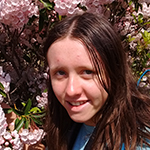Photographs from Dr. Georgia Ennis.
Starting at the pre-dawn hours of 3 or 4 AM, the Kichwa people of Napo, Ecuador, gather with family and spend time talking and listening and drinking tea, in a tradition known as Wayusa Upina.
In Kichwa, the verb “to listen” also means “to understand,” says Penn State anthropologist Georgia Ennis, who spoke at Duke last week. Wayusa Upina provides natural opportunities for children to learn from parents and grandparents, aunts and uncles. Kichwa pedagogies, Ennis explains, “have a lot less to do with a traditional classroom.”
But as multigenerational households become less common and Kichwa children spend more time in schools, the tradition has become less widespread. Meanwhile, other traditions, like radio programs in Kichwa, are becoming more common, and “the radio ends up filling the space” that multigenerational conversation might otherwise fill. Through music videos, social media, live performances, books, and radio programs, the people of Napo are finding new roles for an old language.
Ennis studies language oppression and reclamation and is broadly interested in the relationship between ecological and linguistic change. “How can we bring language and the environment together?” she asks. While her work was initially focused on language standardization, she became interested in the environmental aspects during her research. The two issues aren’t separate; they are linked in complex ways. To explain ecology in a linguistic sense, Dr. Ennis offers a definition from Einar Haugen: “Language ecology may be defined as the study of interactions between any given language and its environment… The true environment of a language is the society that uses it as one of its codes.”
Many scientists believe we are witnessing a sixth mass extinction, and extinction is occurring at unprecedented rates, but Dr. Ennis says we are losing another kind of diversity as well: the diversity of languages. Her own work focuses on Upper Napo Kichwa in the Ecuadorian Amazon. Though there are 47,000 speakers, there has been a language shift toward Spanish among younger generations. “Spanish really remains the dominant language of social life,” she says, even though the majority of the residents are Kichwa.
The concept of “language endangerment,” or the rapid loss of marginalized languages as speakers adopt dominant languages instead, is complex and not without its critics. Dr. Ennis believes languages like Kichwa are “actively oppressed,” not passively endangered.
There are eight varieties of Kichwa in the Andean highlands and the Amazon. “Unified Kichwa,” which Dr. Ennis says is based on reconstruction of Andean varieties, was adopted as an official language of Ecuador in 2008, but this standardized version fails to capture local variation. In Napo, Dr. Ennis found that “the regional linguistic varieties were understood to be inherited from your elders.” Initially, she had “a much stronger stance” against standardized language, but she now sees certain benefits to Unified Kichwa. It can, for instance, help encourage bilingual education. Still, it risks outcompeting local dialects. Many of the people she worked with in Napo are actively trying to prevent that.
The reverse of language endangerment or oppression is language revitalization or reclamation, which aims to preserve linguistic diversity by increasing the number of speakers and broadening the use of language. Media production, for instance, can help create social, political, and economic value for Upper Napo Kichwa.
In Napo, Dr. Ennis realized that many Kichwa are interested in reclaiming more than just language. They are also working to preserve traditional environmental practices and intergenerational pedagogies. None of these issues exist in a vacuum, and recognizing their links is important. Dr. Ennis wants people to realize that “ecologies are more than just biological ecosystems.” Through the course of her work, she’s become more aware of the ties between linguistic and environmental issues. Environmental issues, she says, are present in daily life; they shape what people talk about. Conversations like these are essential. Whether in radio programs or casual discussions, political debates or household conversations before the sun has risen, the things we talk about and the stories we tell affect how we view the world and how we respond to it.

